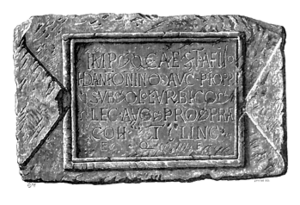Quintus Lollius Urbicus facts for kids
Quick facts for kids
Quintus Lollius Urbicus
|
|
|---|---|

RIB 1276
|
|
| Governor of Roman Britain | |
| In office 139 A.D. – 142 A.D. |
|
| Personal details | |
| Born | Tiddis |
| Died | Rome |
| Parents | Marcus Lollius Senecio, Grania Honorata |
| Occupation | Governor |
Quintus Lollius Urbicus was an important Roman leader from North Africa. He was a Numidian Berber man who became a governor of Roman Britain. This was a part of the Roman Empire, which included much of what is now England and Wales. He was in charge between the years 139 and 142 AD. This was during the time when Antoninus Pius was the Emperor.
We know about Lollius Urbicus from old Roman writings and from five stone carvings found in Britain. More details about his life are written on two stone carvings found in his hometown of Tiddis, which was in Numidia (modern-day Algeria).
Contents
Growing Up
Quintus Lollius Urbicus was the son of Marcus Lollius Senecio. His father was a wealthy landowner from the Numidian Berber people. His mother's name was Grania Honorata.
Historians believe that Urbicus was part of a group of important people from his hometown of Cirta who lived in Rome. This group included other famous Romans like Publius Pactumeius Clemens and Marcus Cornelius Fronto. Urbicus and Clemens later helped Fronto start his career as a speaker.
Early Career Steps
We know a lot about Lollius Urbicus's early career from a detailed stone carving found in Tiddis.
Military Service
His career began in the Roman army. He was a military leader, called a tribune, with a group of soldiers known as the Legio XXII Primigenia. This group was stationed in a place called Mogontiacum, which is now Mainz in Germany.
Joining the Senate
After his military service, he became a member of the Roman Senate. This was a powerful group of leaders in Rome. For one year, he worked as an assistant to the governor of Proconsular Asia, a Roman province in what is now Turkey.
Rising Through the Ranks
Lollius Urbicus quickly became well-known. Emperor Hadrian himself supported his career. Urbicus was put in charge of another group of soldiers, the Legio X Gemina, in Vienna (modern-day Austria).
He received special military awards, called dona militaria. These were for his brave service during Emperor Hadrian's war against the Jewish people, known as the Bar Kokhba Revolt, which happened between 132 and 135 AD.
Becoming a Consul
Around 135 or 136 AD, he became a consul. This was one of the highest positions in the Roman government. After this, he was made the governor of Germania Inferior, a Roman province in what is now the Netherlands and Germany. Soon after Emperor Hadrian died, Urbicus was sent to Roman Britain.
Governor of Britain
When Lollius Urbicus became governor of Britain, Emperor Antoninus Pius wanted to take back control of areas that Hadrian had given up. Urbicus was sent to conquer Lowland Scotland.
Preparing for Battle
Between 139 and 140 AD, Urbicus got the fort at Corbridge ready. This was in preparation for moving his army north of Hadrian's Wall. In 142 AD, special coins were made to celebrate a victory in Britain. This means Urbicus likely led the Roman army to take back southern Scotland in 141 AD. He probably used all three Roman legions and many helper units.
Building the Antonine Wall
In 143 AD, Urbicus started building the Antonine Wall. This was a new wall across Scotland. His name is clearly written on stone carvings found at Balmuildy, which was part of the wall.
The Campaign in Scotland
There are no old writings that fully describe the Roman invasion of Scotland under Urbicus. However, we can guess how it happened.
- Urbicus likely fought against several local tribes in Scotland. These included the Votadini, Selgovae, Damnonii, and Novantae.
- All three Roman legions in Britain took part:
- The Legio II Augusta from Caerleon.
- The Legio VI Victrix from York.
- The Legio XX Valeria Victrix from Chester.
- Many helper units, called auxiliaries, also supported the legions.
Urbicus probably planned his attack from Corbridge in Northumberland. From there, he moved north into the Scottish Borders. He set up forts along the way, like at High Rochester and Newstead. These forts helped the Romans control the local tribes.
He also made sure there was a way to get supplies, like food, to his army. He likely set up a supply port at Carriden. After securing these areas, he then moved against the Dumnonii tribe. Finally, he oversaw the building of the Antonine Wall. This wall was made of turf and timber and stretched for about 35 miles between the Rivers Forth and Clyde.
Later Life
After his time in Britain, Urbicus went back to Rome. He was given a very important job: praefectus urbi, or Prefect of Rome. This person was in charge of the city of Rome. He likely held this position in 146 AD. He might have been the prefect who died in 160 AD.
While he was Prefect of Rome, Urbicus was involved in a famous trial. A woman named Ptolemaeus was accused by her ex-husband of being a Christian. She told Urbicus that she was indeed a Christian, and he sentenced her to death. This event led Justin Martyr, a Christian writer, to write his Apology to try and save her life.
Historian Colin Wells noted how amazing Urbicus's career was. He said that it was rare for the son of a Berber landowner from a small town to travel so widely and achieve such high power in the Roman Empire.
See also
- Lollia (gens)
Images for kids


